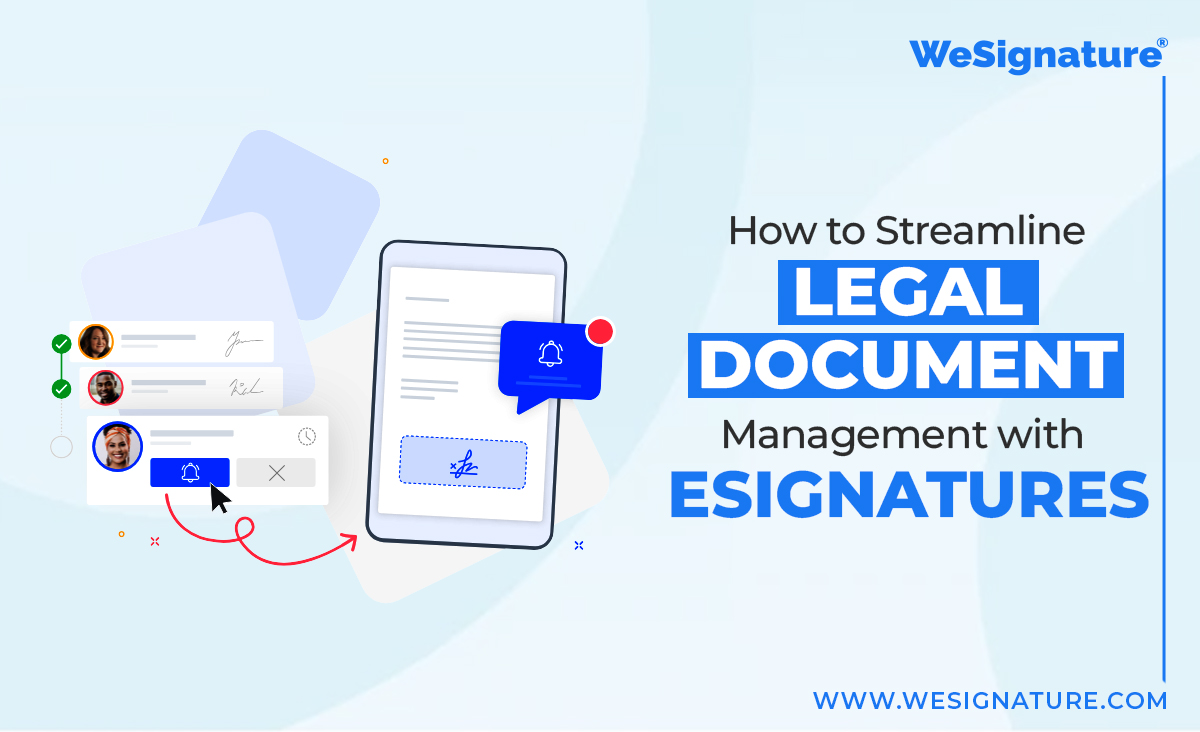Legal services in particular and work in general require work efficiency in the modern day and in the contemporary legal world more so. Attorneys are always in the search for more effective and efficient ways of working so as to minimize bureaucracy as well as improve on the value they offer to the clients. They have made integration of eSignatures possible and are considered as one of the most important innovations in the recent past. This e-technology has brought drastic change into the Legal Document Management ; it has the advantage that can be even said to be invaluable.
In this blog, you will learn the way of digitization and how exactly eSignatures can make the work of legal companies and lawyers easier.
Understanding eSignatures
It is crucial to lay the groundwork of the knowledge regarding what exactly are the eSignatures and how does it work before plunging into the details of the effectiveness of eSignatures in managing legal documents.
Electronic signature, or e-signature, is a technological tool that can facilitate a signature made on an electronic device. eSignatures are as legal as the traditional form of signing and as permitted in many countries of the world including United States under the ESIGN Act and in the European Union under the eIDAS Regulation of EU.
The eSignatures can be categorized depending on their complexity, from a simple type of name to the complex biometric signature, which works on the basis of fingerprints or facial features.
The thing is that it provides the same or, in some cases, even greater level of confidentiality and guarantee for signing documents without a physical meeting or a piece of paper.
The Benefits of eSignatures in Legal Document Management
1. Increased Efficiency and Speed
Of all the benefits of eSignatures, getting documents signed and processed is probably one of the fastest. The conventional manual signing procedures involve paperwork which is tedious and sometimes involves steps like printing, mailing or faxing the documents to recipients, waiting for the signatures, scanning or even filing the signed documents and many more.
As for eSignatures, signing of a document and its subsequent return can take minutes and does not depend on the signature’s location. This speed is especially of great advantage in the legal field whereby quick processing of documents can sometimes be very crucial.
2. Cost Savings
The first benefit is the cost factor which is greatly reduced by the adoption of eSignatures. Reductions in paper, printing, postage and storage costs can be achieved given that law firms and legal departments will eliminate or reduce their physical usage of papers. Also, it frees up a lot of time that was previously spent on the administrative side, which can now be spent on more business generating work, thus increasing efficiency and profitability.
3. Enhanced Security and Compliance
Security is always a concern in the legal field, however eSignatures provide a high level of protection to the documents. eSignatures employ techniques such as encryption and other related features in order to guarantee document’s authenticity and its content’s integrity. Moreover, most eSignature solutions offer a comprehensive history feature that displays information about signing activities such as time stamps and source addresses. This level of transparency, and accountability aids compliance towards legal and regulatory provisions.
4. Improved Client Experience
With the current developments in the market today, clients demand convenience and speed. eSignatures are highly convenient for the end user and can improve the satisfaction of clients. The ability to sign documents is available anytime, anywhere, from any device for clients. This flexibility is especially beneficial to the clients, especially when they have tight working schedules or come from different areas.
5. Environmental Benefits
It is equally important not to overlook the environmental implications of curbing paper consumption. Therefore, the use of eSignatures gives law firms and legal departments their part in helping to save the environment from pollution by eliminating the use of papers. Such approach not only has positive impact on environment but also for the firm, as environmentally friendly is often attractive for clients.
Implementing eSignatures in Legal Document Management
Implementing eSignatures in legal document management requires careful planning and consideration. Here are some key steps to ensure a successful transition:
1. Choose the Right eSignature Solution
The number of eSignature solutions are vast, and each has its unique skills and services to offer. As for the eSignature’s complexity, the evaluation criteria may include security, compliance with the necessary standards, user-friendliness, compatibility with used platforms, and the price. Some of the market-leading eSignature solutions are as follows: DocuSign, Adobe Sign, SignNow, and many others.
2. Ensure Legal Compliance
Although eSignatures are legal in many countries, there is a necessity to consider the given legal status operating within the particular region. However, it is crucial that the eSignature solution of your choice is legal by adhering to the prevailing laws and policies like the ESIGN Act as used in the United States or the eIDAS Regulation as used within the European Union.
3. Integrate with Existing Systems
To enhance the value that is being delivered by the eSignatures, ensure that the chosen platform is integrated into the current document management system and evolutions systems. Since this integration is going to cover all documents right from their creation till final signature, there would be least disruption to pass onto a paperless environment.
4. Train Staff and Clients
Implementation of new technology should be accompanied by staff and client training. Schedule and conduct numerous training sessions to ensure that all the users of the eSignature platform know how to operate it to the optimum. Provide assistance should there be any issues or questions that may come up during the transition process.
5. Establish Clear Processes and Policies
Simply implementing new technology is not enough, people must be trained on how to use the technology and the clients as well. Organize detailed training for all company’s employees to show everyone how the eSignature works. Extend hands of assistance because questions and concerns might arise from the changes.
6. Monitor and Evaluate
Once eSignatures have been deployed, one needs to follow up on the process to ensure that there is an opportunity for optimization. Get feedback from staff and clients in order to ascertain whether the platform is relevant and useful to them. Periodically assess legal and regulatory compliance to ensure your document management system is proper.
Overcoming Common Challenges with eSignatures
The benefits of eSignatures are therefore obvious, although one is likely to come across certain challenges when implementing this tool in their firm. Knowledge of these issues would help in a smooth transition in a different level of practice.
1. Resistance to Change
Despite the various benefits associated with use of the boom, there could be resistance to change amongst the staff and the clients due to previous experience in manual, paper based systems. To combat this, make sure to highlight all the positive aspects of eSignatures and dedicate sufficient time for training and assistance in using it.
2. Technical Issues
There may be some software integration problems with the current system, or the eSignature application may present a challenge. Pay special attention to IT department or your preferred vendor and resolve any IT issues you may encounter when implementing the LMS.
3. Legal and Regulatory Concerns
Particularly, the legal and the regulations related to ICOs remain largely unclear, convoluted, and ambiguous. Always update your knowledge about the changes on the legal requirements on eSignatures and consult a lawyer when necessary.
4. Security Concerns
ESignatures are secure enough, but generally there might be some security concerns over digital signature. All staff and clients need to be made aware of the security precautions in place and the benefits of using electronic signatures instead of manual ones.
Real-World Applications of eSignatures in Legal Document Management
Before we look into how eSignatures work, it’s best if we dive deeper into examples within the legal niche.
1. Client Agreements
Law firms can apply e-signatures in the execution of client agreement documents. This allows clients to sign electronic copies immediately, replacing the manual posting of physical copies for signing. Not only does this accelerate the time to get the client up to speed, but it also improves the client satisfaction.
2. Court Filings
eSignatures can attest to the filings of papers in court if the area allows electronic filing. There is a document production where legal professionals can input and sign the documents they prepare.
3. Contract Management
Contract management may be a tiresome affair when one or more parties are involved in the process. Due to eSignatures, it becomes easier to sign contracts and other forms since all the parties are able to review and sign them fast. This is especially the case where the transaction is large and involves other transactions like mergers and acquisitions that need to be done as soon as possible.
4. Internal Approvals
But eSignatures can also help an organization’s intra-organisation processes, such as within a law firm or a legal department. For instance, eSignatures can speed up approval processes involving operational expenses, company policies, internal memos, and more, eradicating bureaucratic hold-ups.
5. Compliance Documentation
Adhering to legal compliance standards is sometimes complex and will require writing a lot. eSignatures make compliance signature and documentation processes more secure and efficient, enabling free access to the records that are important for compliance.
The Future of eSignatures in the Legal Industry
As technology continues to advance, the use of legal eSignatures in the industry is likely to expand further. Here are some trends to watch for in the coming years:
1. Increased Adoption of Blockchain Technology
Blockchain technology has the potential to provide lower risks to cyberspace and increased control over the execution of binary transactions. Combining eSignatures with blockchain technology means that once you create signed documentation, the blockchain offers an even higher level of security and trust to the legal process.
2. Artificial Intelligence and Automation
Artificial intelligence AI and automation are apparent in different fields of the legal industry including eSignatures. AI in eSignature solutions automates repetitive tasks like document creation and validation, enhancing paper management.
3. Enhanced Mobile Capabilities
Platforms for eSigning continue to improve their functionality across the more advanced and widespread use of mobility. This increases flexibility, as both legal professionals and clients can literally send and sign documents using their smartphones or tablets.
4. Global Standardization
The globalization of legal services requires standardization of eSignature across different jurisdictions due to the following reasons. Efforts to standardize eSignature laws and regulations on the global level will make cross-border business more efficient.
Conclusion
Law companies and legal departments will find that eSignature integration transforms legal document handling. This technology offers a better customer experience while strengthening security and compliance, increasing efficiency, and lowering expenses.
Legal practitioners may remain competitive in a fast changing business and streamline their operations by implementing eSignatures, such those offered by WeSignature. With WeSignature, you can embrace the future of legal document management and revolutionize the way you now handle legal documents.




